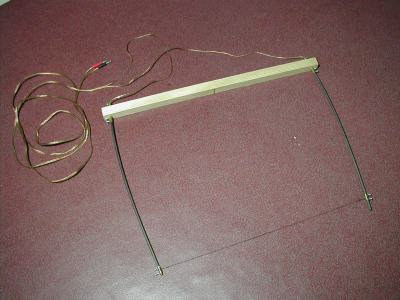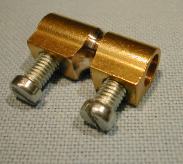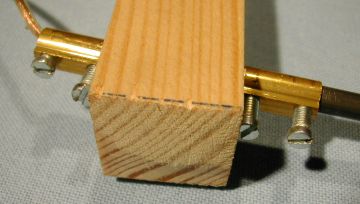Tools
A foam cutter
A foam cutter
![]() There is already plenty of descriptions of
cutting bows (for foam, Depron or other similar materials) especially
on Internet ! However, I will try to put my own modest contribution
to it with a design as simple as possible and a bow which can be
easily adjusted to any size depending on your needs.
There is already plenty of descriptions of
cutting bows (for foam, Depron or other similar materials) especially
on Internet ! However, I will try to put my own modest contribution
to it with a design as simple as possible and a bow which can be
easily adjusted to any size depending on your needs.
List of material:
- A piece of wood (pine) with a 27x27 mm section (length 65 cm),
- A piano wire - diameter 6 mm (2 lengths of 50 cm each),
- 6 junction boxes (section 16 or, even better, 25 mm2),
- A piano wire - diameter 6/10 mm (cutting wire).
Construction:
![]() I think the drawing and the pictures below will
give you all the details. The junction boxes are used for fixing and
securing the branches(6 mm music wires) on the back of the bow and
for connection of the power cord as well. The other two junction
boxes used for the attachment of the cutting wire on the branches
have got a groove (machined with a drilling machine or a lathe and a
rat-tailed file) in order to avoid any constraint on the cutting wire
where it is attached. The length of the cutting wire is adjusted to
get the proper tension.
I think the drawing and the pictures below will
give you all the details. The junction boxes are used for fixing and
securing the branches(6 mm music wires) on the back of the bow and
for connection of the power cord as well. The other two junction
boxes used for the attachment of the cutting wire on the branches
have got a groove (machined with a drilling machine or a lathe and a
rat-tailed file) in order to avoid any constraint on the cutting wire
where it is attached. The length of the cutting wire is adjusted to
get the proper tension.
![]() With this design, you can easily change the
diameter of the cutting wire on the same bow. As far as I am
concerned, I use either a 6/10 mm piano wire (feed with about 10 V -
6 A) or a Graupner Ni-Cr 3/10 mm wire, reference 849 (feed with about
12 V - 1,2 A).
With this design, you can easily change the
diameter of the cutting wire on the same bow. As far as I am
concerned, I use either a 6/10 mm piano wire (feed with about 10 V -
6 A) or a Graupner Ni-Cr 3/10 mm wire, reference 849 (feed with about
12 V - 1,2 A).
| |

| |

|

|
|
|
|

|

|
|
|
|
 | |
|
| |
Power supply:
![]() It depends on the cutting wire you will use. A
regulated DC power supply adjustable from 0 to 15 V - 10 A (DC) is
suitable for the cutting wires mentioned above. With the dimensions
of the cutter given above and the Graupner wire (ref. 849 -
consumption 12 V - 1,2 A), even a single 12 V battery will do it.
Another idea is to use a battery (12 V for example) associated with
an ESC for electric motor (the one you use in your planes) ; you will
adjust the current using a servo tester (or even your transmitter and
your receiver - throttle channel !).
It depends on the cutting wire you will use. A
regulated DC power supply adjustable from 0 to 15 V - 10 A (DC) is
suitable for the cutting wires mentioned above. With the dimensions
of the cutter given above and the Graupner wire (ref. 849 -
consumption 12 V - 1,2 A), even a single 12 V battery will do it.
Another idea is to use a battery (12 V for example) associated with
an ESC for electric motor (the one you use in your planes) ; you will
adjust the current using a servo tester (or even your transmitter and
your receiver - throttle channel !).
Utilisation:
![]() You will find on the following sites examples and
advice to make use of cutting bows :
You will find on the following sites examples and
advice to make use of cutting bows :
- SeaGull Technologies: The aeromodelling page.
- F5B-UK Web site: Hot wire machine.
- Aeropic: A machine to cut out polystyrene.
![]() On the SeaGull's site, You will also find a
simple foam calculator for cutting trapezoidal wings.
On the SeaGull's site, You will also find a
simple foam calculator for cutting trapezoidal wings.
- For Mac PPC : FoamCalc.PPC
- For PC : FOAMCALC.EXE
Caution !
![]() The fumes emitted while
cutting are extremely toxic. Do not inhale them and work only in a
well ventilated room.
The fumes emitted while
cutting are extremely toxic. Do not inhale them and work only in a
well ventilated room.